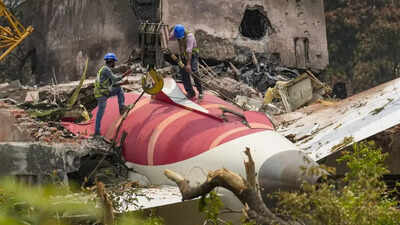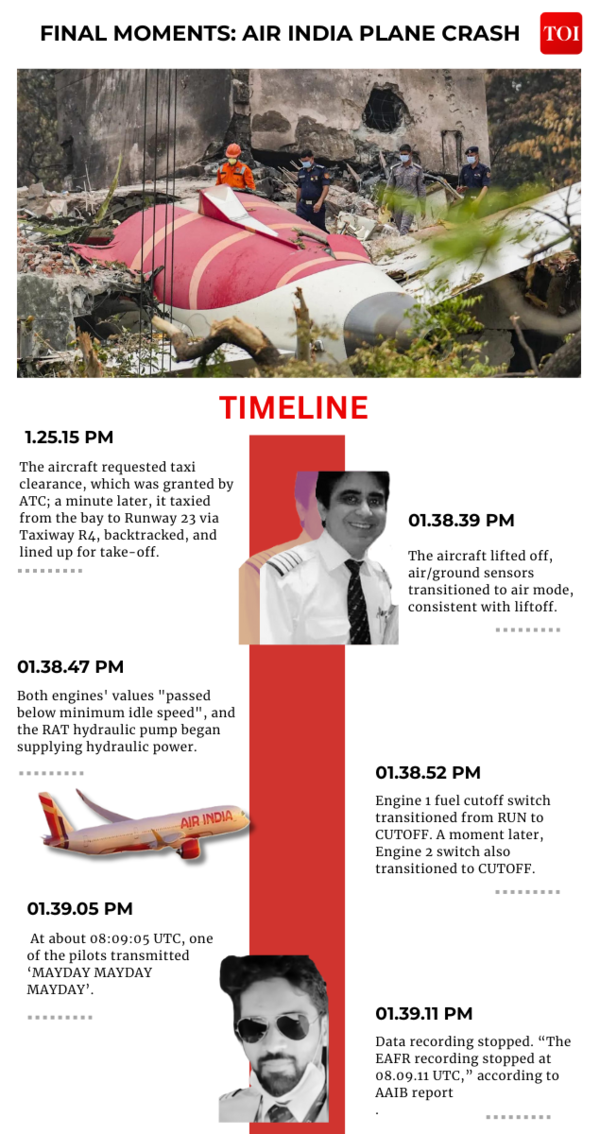ARTICLE AD BOX

In its first official account of the June 12 crash that killed 260 people in Ahmedabad, the Aircraft Accident Investigation Bureau (AAIB) has released a 15-page preliminary report into Air India Flight 171.
The Boeing 787-8 Dreamliner plunged into a medical college hostel moments after takeoff, becoming one of India’s worst aviation tragedies in decades and the first fatal crash of a Dreamliner globally.The report stops short of assigning blame but outlines a chilling sequence of events: both engine fuel control switches were inexplicably moved from "RUN" to "CUTOFF" within a second of each other, starving the aircraft’s engines of fuel.
Cockpit voice recordings captured one pilot asking the other why he had shut off the fuel. The other denied doing so.

Despite relighting both engines, only one recovered fully before the plane crashed just 32 seconds after becoming airborne. The switches were later found back in the "RUN" position. While mechanical failure, bird strike and fuel contamination have been ruled out, the mystery of how the switches were moved persists, prompting calls for further forensic analysis and voice identification.
What the report answers
What triggered the dual engine flame-out?Roughly seven seconds after lift-off, both fuel switches were cut to CUTOFF in less than one second, depriving the engines of fuel and leading to a thrust loss. The Ram Air Turbine (RAT) swung into action to supply emergency power—which was captured on CCTV footage shortly thereafter.Did the pilots attempt an engine restart?Yes. The Enhanced Airborne Flight Recorder (EAFR) shows that around 10 seconds after the cutoff, both switches were returned to RUN, and one engine began recovering.
However, the altitude was insufficient for a full restoration of thrust before crashing.Was fuel contamination a factor?No. DGCA lab tests on samples from the refuelling bowsers and tanks found the fuel to be satisfactory.What did cockpit audio reveal?The CVR captured a pilot asking, “Why did you cut off?” with the response, “I did not do so,” but identities were not assigned to either speaker.Was the aircraft airworthy?Yes.
All mandatory checks had been completed. However, an advisory issued by the FAA in 2018 concerning fuel switch locking mechanisms was not acted upon, as it was classified as non-mandatory. The VT-ANB underwent throttle control module replacements in 2019 and 2023, with no reported fuel switch defects since, TOI reported..Were flight crew and procedures followed?Both pilots passed pre-flight breathalyser tests and were visible on CCTV pre-departure.
The captain, Sumeet Sabharwal, had over 15,000 flying hours (8,600 on the 787), while First Officer Clive Kunder had 3,400 hours. Sabharwal was monitoring, Kunder was flying.
What still remains uncertain
Could the engine electronic control unit (ECU) be at fault?TOI reports that veteran commanders referenced a 2021 joint FAA–GE Service Bulletin recommending replacement of the “MN4 microprocessor” on the engine’s ECU—citing solder-ball fatigue due to thermal cycling that might lead to electrical faults.
A failure here could plausibly trigger unintended switch activation.Why wasn’t the landing gear retracted?The report notes the gear was still down. One theory is that the crew was preoccupied with engine failure procedures and had no opportunity to retract the gear. Audit transcripts make no mention of the “positive climb” or “gear up” call being made.Why is there no cockpit video?Experts like Peter Goelz of the NTSB have lamented the lack of visual cockpit recording, which could definitively identify who moved the switches, BBC reported.Could it have been an electrical glitch?Former AAIB investigator Capt Kishore Chinta, while speaking with BBC raised the question of whether the ECU or other systems could have electronically tripped the fuel switches—adding to suspicions of a microprocessor fault.Was the Emergency Locator Transmitter (ELT) operational?Capt Amit Singh, told TOI that the ELT failed to emit a distress signal—despite impacts of 3.2 to 3.5 g ordinarily triggering it. He also questioned discrepancies in the RAT deployment timeline and the lack of cockpit conversation timestamps.Who is on the investigative panel?TOI had also reported that Capt Sam Thomas of the Airline Pilots’ Association of India raised doubts about the expertise composition of the AAIB team. The AAIB has since confirmed the inclusion of subject-matter experts: pilots, engineers, aviation medicine specialists and flight-recording experts supporting the core investigation team.When is the final report expected?According to AAIB, the comprehensive report is due by 12 June 2026. Until then, no definitive cause has been declared, nor have safety directives been issued for 787-8 operators or GE’s GEnx-1B engines.



.png)
.png)
.png)
















 4 hours ago
5
4 hours ago
5









 English (US) ·
English (US) ·